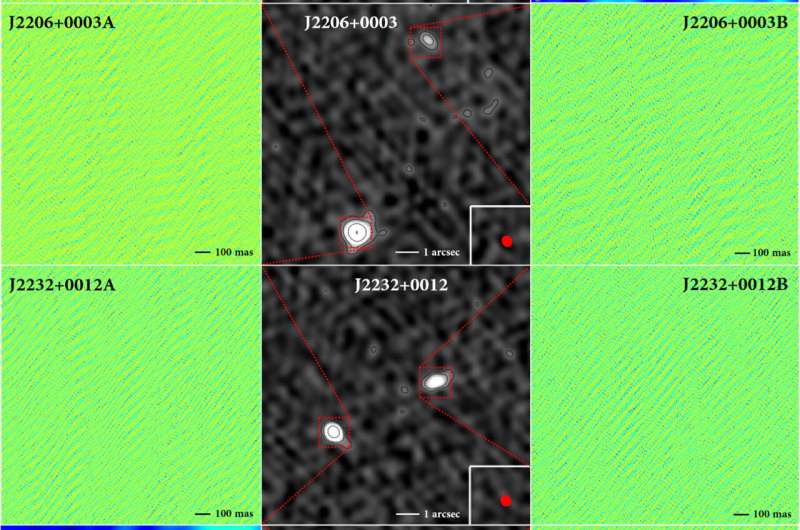This article has been reviewed according to Science X's editorial process and policies. Editors have highlighted the following attributes while ensuring the content's credibility:
fact-checked
peer-reviewed publication
trusted source
proofread
Researchers reveal parsec-scale radio emission properties of dual AGNs by multi-phase-center VLBI observations

Galaxy mergers play a crucial role in the cosmological evolution of galaxies. During galaxy merging, tidal torques can trigger the accretion and feedback of the central black holes in merging galaxies, forming dual active galactic nuclei (AGNs).
However, such confirmed dual-AGN instances are quite rare currently. Further merging of dual AGNs could form supermassive black hole binaries, which are important sources of low-frequency gravitational waves in the universe.
Studying the emission properties of dual AGNs not only helps to understand galaxy mergers and evolution but also plays an important role in the advancement of multi-messenger astronomy.
In a recent study published in The Astrophysical Journal, Xu Wancheng, a graduate student supervised by Prof. Cui Lang and Prof. Liu Xiang from the Xinjiang Astronomical Observatory (XAO) of the Chinese Academy of Sciences, along with the collaborators, conducted phase-referenced observations using the Very Long Baseline Array (VLBA) at 5 GHz on four confirmed radio-selected dual AGNs in Stripe 82 region.
The researchers obtained high-resolution radio images of eight sub-sources in the four dual AGNs based on multi-phase-center technique, and successfully detected two compact radio cores corresponding to J0051+0020B and J2300-0005A.
These two sub-sources exhibited high brightness temperature (>106 K) and radio emission power (>1021 W/Hz), showing typical characteristics of compact radio jets. The other six components were not detected by VLBA and their 5 GHz radio emission was resolved out in the high-resolution images.
Based on the VLBA observations and multi-band properties such as optical and X-ray data of target sources, the researchers analyzed the 5 GHz radio emission origins of each component in the four dual AGNs, and studied the differences between dual AGNs and isolated AGNs.
The findings supported the feasibility and advantages of wide-field Very Long Baseline Interferometry (VLBI), a potent tool for high-resolution imaging and precise astrometric measurements, in determining the positions of black holes in dual AGNs and characterizing their compact radio emissions.
Through multiband observations, the four radio-selected dual AGNs in Stripe 82 region were confirmed. In addition, the multiband and multiscale observational studies on rare and reliable dual-AGN sources help to reveal the complex process of galaxy mergers.
This study provides valuable insights into future in-depth analyses and discussions on observational studies of larger dual-AGN samples.
More information: Wancheng Xu et al, Very Long Baseline Array Observations of Parsec-scale Radio Emission in Dual Active Galactic Nuclei, The Astrophysical Journal (2024). DOI: 10.3847/1538-4357/ad463b
Journal information: Astrophysical Journal
Provided by Chinese Academy of Sciences





















